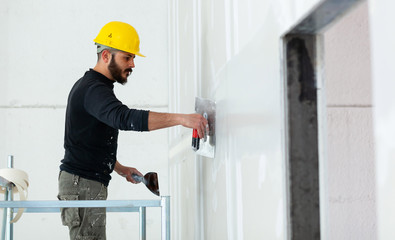Drywall repair is one of the least difficult and most satisfying home improvement projects you can do yourself. The materials are cheap, and the labor is straightforward. Read on Drywall Repair Las Vegas to learn more.
 Generally, holes in drywall are easy to fix, but larger ones require more time and skill. Depending on the size and type of damage, your drywall repair may involve replacing a section or whole drywall sheet. Whether it’s an accidental doorknob knock or a misguided hockey puck, your walls can sometimes get damaged. But with a little know-how, you can repair drywall and keep your home looking its best.
Generally, holes in drywall are easy to fix, but larger ones require more time and skill. Depending on the size and type of damage, your drywall repair may involve replacing a section or whole drywall sheet. Whether it’s an accidental doorknob knock or a misguided hockey puck, your walls can sometimes get damaged. But with a little know-how, you can repair drywall and keep your home looking its best.
Minor dents, nail holes and dings can be repaired with spackle or joint compound. However, larger holes require a patch of new drywall. A hole can be small enough to fill with a dab of paint that covers up the damage, but bigger patches can leave a noticeable gap between the old and new. That’s where a good quality primer and paint come in handy.
When repairing water damaged drywall, it is essential to remove as much water as possible before continuing. This will prevent any further damage and help the walls dry faster.
If you’re looking to change up your decor, but don’t want to put up new drywall, it may be time to remove that old wallpaper. But it can be difficult and messy.
First, you need to prep the area. This means removing curtains, outlet covers, switchplates and any artwork. It also means protecting your floors by laying down a plastic painter’s tarp or covering them with a sheet of plastic.
Once you’re ready to begin, spray a wallpaper remover solution over your wall (follow instructions from manufacturer). Apply this to a small, workable section of the wall at a time.
Next, test a seam or corner to see if it comes up easily and doesn’t tear the underlying drywall paper. If it does, the paper is probably peelable and removal will be easy.
Water damage can occur from a variety of sources, including plumbing leaks, foundation or structural failures and flooding. These events are unavoidable in many areas, but taking action to minimize the damage can make all the difference in your home’s long-term health and safety.
When a water damage event occurs, it’s crucial to immediately find and stop the source of the water. This is essential to preventing further damage and mold growth from occurring inside your home’s drywall.
Drywall can be impacted by water in a number of ways, ranging from slight staining to serious structural damage. If you notice cracking paint, bubbling wallpaper or musty odors, it’s time to act!
Drywall cracks can be an indication of a structural problem that needs to be repaired. Typically, these cracks are seen on the seams where two sheets of drywall meet.
If you find a drywall crack that runs diagonally, it may be due to a foundation issue. This is a big warning sign that something serious is going on with your home and should be taken care of immediately.
Newly built homes are prone to minor wall cracks that occur as the fresh lumber dries and settles into the walls. This settling can cause the wood to shift slightly, so it’s important to wait a year before repairing any wall cracks in newly constructed homes.
These cracks are generally easy to repair, though they can sometimes be tricky to fix if they are in areas that have a different texture than the rest of the wall. If you have a textured wall, taping over the crack and adding new texture and paint on top can be an effective way to cover up the crack.
Drywall is a pretty tough material, but holes can still happen. They can be caused by anything from a wayward doorknob or hammer to a rambunctious kid.
While small drywall repairs can be done by homeowners, large ones require some professional help. Here are some tips on drywall repair to keep in mind.
Drywall seams and joints crack because the drywall is subject to movement from a variety of factors. This includes environmental conditions (such as a home that is left vacant for long periods of time) and foundation problems.
Usually, the cracks are harmless, though some can be a sign of something more serious. For example, if vertical cracks run at an angle or are wider than a quarter inch, the crack may indicate that the foundation has shifted or that there is water damage in the building.
Most drywall cracks can be repaired quickly, inexpensively and safely by re-taping the joint. This will reinforce the surface, reducing the likelihood of the crack reappearing in the future.
Drywall is a solid, durable material that’s used in the construction of walls. However, drywall can also become damaged by nails or other objects that puncture it. The result can be a hole in the wall that is unattractive or even dangerous.
Repairing holes in drywall can be tricky and requires a lot of know-how and tools. Large holes, for example, are difficult to fix by hand and require a professional repair.
The first step is to clean the area of drywall debris and dirt. This will help prevent a patch from sticking to the wall and creating an uneven repair.
After sanding the damaged area, use a putty knife to fill in the hole. Then, spread a thin layer of joint compound over the patch.
For smaller holes, about the size of a doorknob, you can use a patch kit that comes with a mesh patch. These patches are self-adhesive, so you place them over the hole and cover it with joint compound.
Sagging is a common problem with drywall. It can be caused by a number of factors, including poor construction, undersized drywall and water damage.
A good first step is to see if the drywall used is the correct size. While 1/2″ drywall is very popular, it’s a little light and won’t be as sturdy as 5/8″ thick drywall.
Another potential cause of sagging is termites. They’ll eat through the supporting ceiling joists, weakening them and exerting more force on the drywall below.
This is a big problem because termites can be hard to spot and are typically found in older homes.
Other issues that can contribute to sagging in drywall include water damage, leaks, earthquakes and poor construction. In addition, sagging can be the result of seasonal temperature changes. This is something that should be addressed in your upcoming home inspections. Having a professional inspect your home before any repairs are made will prevent problems in the future and save you money in the long run.
Drywall is a common type of building material, and it has many advantages over other options. For example, it aids in fire protection and mildew prevention.
However, it is also susceptible to water damage from hidden leaks. It is very important to identify the source of water damage and call for professional drywall repair services.
When a water-related issue is not addressed quickly, mold will begin to grow on the drywall in just 24 to 48 hours. In addition, the spores will spread throughout the entire home or commercial property.
This can result in a variety of health issues for the residents or employees of the affected area. These problems can range from allergy symptoms to asthma and even respiratory diseases.

